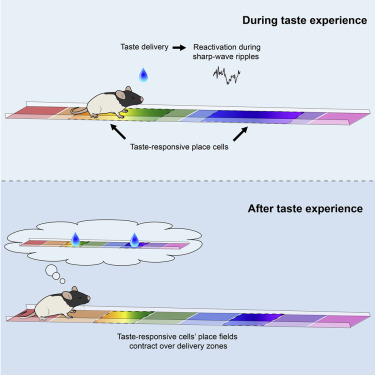当前位置:
X-MOL 学术
›
Curr. Biol.
›
论文详情
Our official English website, www.x-mol.net, welcomes your
feedback! (Note: you will need to create a separate account there.)
Refinement and Reactivation of a Taste-Responsive Hippocampal Network.
Current Biology ( IF 8.1 ) Pub Date : 2020-03-19 , DOI: 10.1016/j.cub.2020.01.063 Linnea E Herzog 1 , Donald B Katz 2 , Shantanu P Jadhav 2
Current Biology ( IF 8.1 ) Pub Date : 2020-03-19 , DOI: 10.1016/j.cub.2020.01.063 Linnea E Herzog 1 , Donald B Katz 2 , Shantanu P Jadhav 2
Affiliation

|
Animals need to remember the locations of nourishing and toxic food sources for survival, a fact that necessitates a mechanism for associating taste experiences with particular places. We have previously identified such responses within hippocampal place cells [1], the activity of which is thought to aid memory-guided behavior by forming a mental map of an animal's environment that can be reshaped through experience [2-7]. It remains unknown, however, whether taste responsiveness is intrinsic to a subset of place cells or emerges as a result of experience that reorganizes spatial maps. Here, we recorded from neurons in the dorsal CA1 region of rats running for palatable tastes delivered via intra-oral cannulae at specific locations on a linear track. We identified a subset of taste-responsive cells that, even prior to taste exposure, had larger place fields than non-taste-responsive cells overlapping with stimulus delivery zones. Taste-responsive cells' place fields then contracted as a result of taste experience, leading to a stronger representation of stimulus delivery zones on the track. Taste-responsive units exhibited increased sharp-wave ripple co-activation during the taste delivery session and subsequent rest periods, which correlated with the degree of place field contraction. Our results reveal that novel taste experience evokes responses within a preconfigured network of taste-responsive hippocampal place cells with large fields, whose spatial representations are refined by sensory experience to signal areas of behavioral salience. This represents a possible mechanism by which animals identify and remember locations where ecologically relevant stimuli are found within their environment.
中文翻译:

提炼和激活味觉响应海马网络。
动物需要记住营养和有毒食物来源的位置才能生存,这一事实需要一种将味觉体验与特定位置相关联的机制。我们以前已经在海马体细胞中发现了这种反应[1],其活动被认为可以通过形成可以通过经验重塑的动物环境心理图来辅助记忆指导的行为[2-7]。然而,味觉响应性是地方细胞的一个子集固有的还是由于重新组织空间图的经验而出现还是未知的。在这里,我们从大鼠的背部CA1区域的神经元记录下来,这些大鼠通过线性轨道上的特定位置通过口内套管传递可口的味道。我们确定了一部分味觉响应细胞,即使在味觉暴露之前,具有比刺激刺激区重叠的无味反应细胞更大的放置场。然后,由于有味觉体验,对味觉敏感的细胞的位置场会收缩,从而导致赛道上刺激传递区域的表现更强。味觉响应单元在味觉传递阶段和随后的休息期间表现出增加的尖波波纹共激活,这与场所收缩的程度相关。我们的结果表明,新颖的味觉体验会在具有大视野的味觉响应海马体细胞的预先配置网络中引起响应,其空间表示通过感官体验来细化,以指示行为显着区域。
更新日期:2020-03-20
中文翻译:

提炼和激活味觉响应海马网络。
动物需要记住营养和有毒食物来源的位置才能生存,这一事实需要一种将味觉体验与特定位置相关联的机制。我们以前已经在海马体细胞中发现了这种反应[1],其活动被认为可以通过形成可以通过经验重塑的动物环境心理图来辅助记忆指导的行为[2-7]。然而,味觉响应性是地方细胞的一个子集固有的还是由于重新组织空间图的经验而出现还是未知的。在这里,我们从大鼠的背部CA1区域的神经元记录下来,这些大鼠通过线性轨道上的特定位置通过口内套管传递可口的味道。我们确定了一部分味觉响应细胞,即使在味觉暴露之前,具有比刺激刺激区重叠的无味反应细胞更大的放置场。然后,由于有味觉体验,对味觉敏感的细胞的位置场会收缩,从而导致赛道上刺激传递区域的表现更强。味觉响应单元在味觉传递阶段和随后的休息期间表现出增加的尖波波纹共激活,这与场所收缩的程度相关。我们的结果表明,新颖的味觉体验会在具有大视野的味觉响应海马体细胞的预先配置网络中引起响应,其空间表示通过感官体验来细化,以指示行为显着区域。










































 京公网安备 11010802027423号
京公网安备 11010802027423号